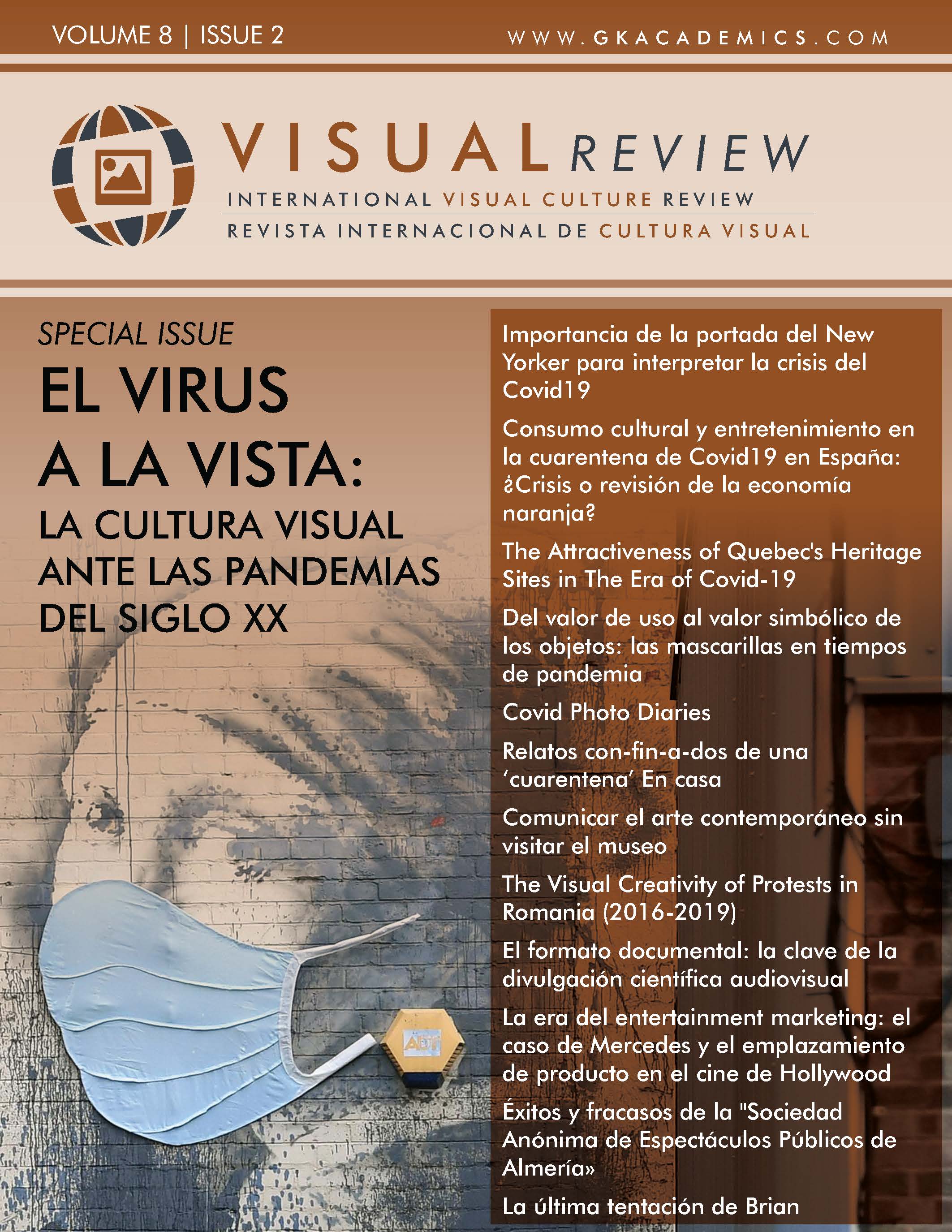The Last Temptation of Brian
From the Controversial Subversion to the Current Reflection
DOI:
https://doi.org/10.37467/gka-revvisual.v8.2837Keywords:
Biblical Cinema, Religion, Christ, Subversion, Controversy, Comedy, DramaAbstract
Biblical films have had widespread and repeated canons since the beginning of cinema, and films opposed to the prevailing film-religious dogma have generated excessive negative reactions. This text focuses on two significant examples of subversion of biblical cinema that addressed the figure of Christ in a new way away from those traditional canons. Their impact still resonates decades later, and this encourages reflection on both their approaches and the controversy. They aroused from a current perspective in which the moral conditioning of audio-visual works is unfortunately very much in evidence.
Downloads
Global Statistics ℹ️
|
419
Views
|
203
Downloads
|
|
622
Total
|
|
References
Aguado Cantabrana, O. (2020, 5 de mayo). El “efecto Gladiator” 20 años después: cine “de romanos”, Champions, memes y extrema derecha. Proyecto ANIHO - ANIWEH Project [Post de blog]. Recuperado el 31 de enero, 2021 de https://aniho.hypotheses.org/2012
Alberich, E. (2009). Películas clave del cine histórico. Barcelona: Robinbook.
Anónimo (1988, 15 de octubre). Escasos incidentes en el estreno en España de ‘La última tentación de Cristo’. El País. Recuperado el 31 de enero, 2021 de https://elpais.com/diario/1988/10/15/cultura/592873206_850215.html
Bermúdez, J.A. (2018). En el nombre del hijo: diez encarnaciones singulares de Jesucristo en el cine. FilmAnd [Post de blog]. Recuperado el 31 de enero, 2021 de http://filmand.es/en-el-nombre-del-hijo-diez-encarnaciones-singulares-de-jesucristo-en-el-cine/
Burnette-Bletsch, R. (2019). The Last Temptation of Christ: Scorsese’s Jesus among Ordinary Saints. In: C.B. Barnett & C.J. Elliston (eds.), Scorsese and Religion (pp. 151-170). Leiden/Boston: Brill. DOI: https://doi.org/10.1163/9789004411401_009
Contreras Guerrero, J. D. (2012, 25 de noviembre). Sobre la historicidad de la película “El discípulo” de E. Ruiz Barrachina. Arqueohistoria crítica [Post de blog]. Recuperado el 31 de enero, 2021 de http://arqueohistoriacritica.blogspot.com/2012/11/el-discipulo-2010-de-emilio-ruiz.html
Dávila Vargas-Machuca, M. (2017). La Gran Manzana según Scorsese: de la infancia a la madurez. In: G. Camarero Gómez (ed.), Ciudades americanas en el cine (pp. 185-202). Madrid: Akal.
Dávila Vargas-Machuca, M. (2020). Kazantzakis y Scorsese, dos autores frente a la controversia: La última tentación (de Cristo). Trasvases Entre La Literatura Y El Cine, 2, 175-209. https://doi.org/10.24310/Trasvasestlc.vi2.9424 DOI: https://doi.org/10.24310/Trasvasestlc.vi2.9424
Dumont, H. (2013). L’Antiquité au Cinéma. Vérités, légendes et manipulations [version PDF augmentée et actualisée]. Paris: Nouveau Monde Editions; Lausanne: Cinémathèque Suisse. Recuperado el 29 de enero, 2021 de http://www.hervedumont.ch/L_ANTIQUITE_AU_CINEMA/files/assets/basic-html/index.html
Eklund, R. (2017). Hot Jesus, Black Messiah, Suffering Son of God: How Jesus Films Shape Our Moral Imaginations. Journal of Religion & Film, 21(1), Article 33. Recuperado el 31 de enero, 2021 de https://digitalcommons.unomaha.edu/jrf/vol21/iss1/33
Elley, D. (1984). The epic film. Myth and History. London: Routledge & Kegan Paul.
España, R. de (2009). La pantalla épica. Los héroes de la Antigüedad vistos por el cine. Madrid: T & B.
Fernández Valentí, T. (2008). Martin Scorsese: un infiltrado en Hollywood. Barcelona: Carena.
Fina, B. de (Productora), & Scorsese, M. (Director). (1988). The Last Temptation of Christ. Estados Unidos; Universal Pictures.
García Iglesias, L. (1995). La Palestina de Jesús. Madrid: Historia 16.
Goldstone, J. (Productor), & Jones, T. (Director). (1979). Monty Python’s Life of Brian. Reino Unido: HandMade Films & Python (Monty) Pictures.
Gonzalez Vaquerizo, H. (2020). La adaptación de la Carta al Greco en el Kazantzakis de Smaragdís. Trasvases Entre La Literatura Y El Cine, 2, 123-140. https://doi.org/10.24310/Trasvasestlc.vi2.9422 DOI: https://doi.org/10.24310/Trasvasestlc.vi2.9422
Gubern, R. (2005). La imagen pornográfica y otras perversiones ópticas. Barcelona: Anagrama.
Gubern, R. (2006). Historia del cine. Barcelona: Lumen.
Kazantzakis, N. [Casandsakis, N.] (2015). La última tentación [trad. y ed. C. Vilela Gallego], Madrid, Cátedra.
Lindlof, T.R. (2008). Hollywood Under Siege: Martin Scorsese, the Religious Right, and the Culture Wars. Lexington: University of Kentucky Press.
López Jimeno, A. (2020). De la Pasión a la revolución. Kazantzakis reinterpretado por Dassin. Trasvases Entre La Literatura Y El Cine, 2, 141-160. https://doi.org/10.24310/Trasvasestlc.vi2.9471 DOI: https://doi.org/10.24310/Trasvasestlc.vi2.9471
Méndiz, A. (2009). Jesucristo en el cine. Madrid: Rialp.
Monterde, J. E. (2000). Martin Scorsese. Madrid: Cátedra.
Pinel, V. (2010). Le cinéma muet. Paris: Larousse.
Scorsese, M. (2005). On Reappreciating Kazantzakis. In: D.J.N. Middleton (ed.), Scandalizing Jesus?: Kazantzakis’s The Last Temptation of Christ Fifty Years On (pp. 229-230). New York/London, Continuum. DOI: https://doi.org/10.5040/9780567691576.ch-018
Solomon, J. (2002). Peplum. El mundo antiguo en el cine. Madrid: Alianza.
Sotinel, T. (2010). Martin Scorsese. Paris: Cahiers du Cinéma Sarl.
Valverde García, A. (2020). Zorba el griego o cuando Nietzsche bailó el syrtaki. Trasvases Entre La Literatura Y El Cine, 2, 161-174. https://doi.org/10.24310/Trasvasestlc.vi2.9444 DOI: https://doi.org/10.24310/Trasvasestlc.vi2.9444
Vilela Gallego, C. (2015). Introducción. In : N. Kazantzakis [N. Casandsakis], La última tentación [trad. y ed. C. Vilela Gallego] (pp. 7-123). Madrid: Cátedra.
Downloads
Published
How to Cite
Issue
Section
License
Those authors who publish in this journal accept the following terms:
-
Authors retain copyright.
-
Authors transfer to the journal the right of first publication. The journal also owns the publishing rights.
-
All published contents are governed by an Attribution-NoDerivatives 4.0 International License.
Access the informative version and legal text of the license. By virtue of this, third parties are allowed to use what is published as long as they mention the authorship of the work and the first publication in this journal. If you transform the material, you may not distribute the modified work. -
Authors may make other independent and additional contractual arrangements for non-exclusive distribution of the version of the article published in this journal (e.g., inclusion in an institutional repository or publication in a book) as long as they clearly indicate that the work was first published in this journal.
- Authors are allowed and recommended to publish their work on the Internet (for example on institutional and personal websites), following the publication of, and referencing the journal, as this could lead to constructive exchanges and a more extensive and quick circulation of published works (see The Effect of Open Access).













